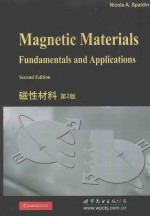图书介绍
磁性材料 第2版 英文PDF|Epub|txt|kindle电子书版本网盘下载

- (美)斯波尔丁(Nicola.A.Spaldin)著 著
- 出版社: 北京:世界图书北京出版公司
- ISBN:9787510087714
- 出版时间:2015
- 标注页数:274页
- 文件大小:47MB
- 文件页数:288页
- 主题词:磁性材料-英文
PDF下载
下载说明
磁性材料 第2版 英文PDF格式电子书版下载
下载的文件为RAR压缩包。需要使用解压软件进行解压得到PDF格式图书。建议使用BT下载工具Free Download Manager进行下载,简称FDM(免费,没有广告,支持多平台)。本站资源全部打包为BT种子。所以需要使用专业的BT下载软件进行下载。如BitComet qBittorrent uTorrent等BT下载工具。迅雷目前由于本站不是热门资源。不推荐使用!后期资源热门了。安装了迅雷也可以迅雷进行下载!
(文件页数 要大于 标注页数,上中下等多册电子书除外)
注意:本站所有压缩包均有解压码: 点击下载压缩包解压工具
图书目录
Ⅰ Basics3
1 Review of basic magnetostatics3
1.1 Magnetic field4
1.1.1 Magnetic poles4
1.1.2 Magnetic flux6
1.1.3 Circulating currents6
1.1.4 Ampère's circuital law7
1.1.5 Biot-Savart law8
1.1.6 Field from a straight wire8
1.2 Magnetic moment10
1.2.1 Magnetic dipole11
1.3 Definitions11
Homework12
2 Magnetization and magnetic materials14
2.1 Magnetic induction and magnetization14
2.2 Flux density15
2.3 Susceptibility and permeability16
2.4 Hysteresis loops18
2.5 Definitions19
2.6 Units and conversions19
Homework20
3 Atomic origins of magnetism22
3.1 Solution of the Schr?dinger equation for a free atom22
3.1.1 What do the quantum numbers represent?25
3.2 The normal Zeeman effect27
3.3 Electron spin30
3.4 Extension to many-electron atoms31
3.4.1 Pauli exclusion principle32
3.5 Spin-orbit coupling32
3.5.1 Russell-Saunders coupling32
3.5.2 Hund's rules34
3.5.3 jj coupling35
3.5.4 The anomalous Zeeman effect35
Homework37
Diamagnetism38
4.1 Observing the diamagnetic effect38
4.2 Diamagnetic susceptibility39
4.3 Diamagnetic substances41
4.4 Uses of diamagnetic materials42
4.5 Superconductivity42
4.5.1 The Meissner effect43
4.5.2 Critical field44
4.5.3 Classification of superconductors44
4.5.4 Superconducting materials44
4.5.5 Applications for superconductors46
Homework46
5 Paramagnetism48
5.1 Langevin theory of paramagnetism49
5.2 The Curie-Weiss law52
5.3 Quenching of orbital angular momentum54
5.4 Pauli paramagnetism55
5.4.1 Energy bands in solids56
5.4.2 Free-electron theory of metals58
5.4.3 Susceptibility of Pauli paramagnets60
5.5 Paramagnetic oxygen62
5.6 Uses of paramagnets63
Homework64
6 Interactions in ferromagnetic materials65
6.1 Weiss molecular field theory66
6.1.1 Spontaneous magnetization66
6.1.2 Effect of temperature on magnetization67
6.2 Origin of the Weiss molecular field69
6.2.1 Quantum mechanics of the He atom70
6.3 Collective-electron theory of ferromagnetism73
6.3.1 The Slater-Pauling curve76
6.4 Summary76
Homework78
7 Ferromagnetic domains79
7.1 Observing domains79
7.2 Why domains occur81
7.2.1 Magnetostatic energy81
7.2.2 Magnetocrystalline energy82
7.2.3 Magnetostrictive energy84
7.3 Domain walls85
7.4 Magnetization and hysteresis87
Homework92
8 Antiferromagnetism96
8.1 Neutron diffraction97
8.2 Weiss theory of antiferromagnetism101
8.2.1 Susceptibility above TN102
8.2.2 Weiss theory at TN103
8.2.3 Spontaneous magnetization below TN103
8.2.4 Susceptibility below TN103
8.3 What causes the negative molecular field?107
8.4 Uses of antiferromagnets110
Homework112
9 Ferrimagnetism113
9.1 Weiss theory of ferrimagnetism114
9.1.1 Weiss theory above TC115
9.1.2 Weiss theory below TC117
9.2 Ferrites120
9.2.1 The cubic ferrites120
9.2.2 The hexagonal ferrites124
9.3 The garnets125
9.4 Half-metallic antiferromagnets126
Homework127
10 Summary of basics130
10.1 Review of types of magnetic ordering130
10.2 Review of physics determining types of magnetic ordering131
Ⅱ Magnetic phenomena135
11 Anisotropy135
11.1 Magnetocrystalline anisotropy135
11.1.1 Origin of magnetocrystalline anisotropy136
11.1.2 Symmetry of magnetocrystalline anisotropy138
11.2 Shape anisotropy139
11.2.1 Demagnetizing field139
11.3 Induced magnetic anisotropy141
11.3.1 Magnetic annealing141
11.3.2 Roll anisotropy142
11.3.3 Explanation for induced magnetic anisotropy142
11.3.4 Other ways of inducing magnetic anisotropy143
Homework144
12 Nanoparticles and thin films145
12.1 Magnetic properties of small particles145
12.1.1 Experimental evidence for single-domain147
particles147
12.1.2 Magnetization mechanism147
12.1.3 Superparamagnetism148
12.2 Thin-film magnetism152
12.2.1 Structure152
12.2.2 Interfaces153
12.2.3 Anisotropy153
12.2.4 How thin is thin?154
12.2.5 The limit of two-dimensionality154
13 Magnetoresistance156
13.1 Magnetoresistance in normal metals157
13.2 Magnetoresistance in ferromagnetic metals158
13.2.1 Anisotropic magnetoresistance158
13.2.2 Magnetoresistance from spontaneous magnetization159
13.2.3 Giant magnetoresistance160
13.3 Colossal magnetoresistance164
13.3.1 Superexchange and double exchange164
Homework168
14 Exchange bias169
14.1 Problems with the simple cartoon mechanism171
14.1.1 Ongoing research on exchange bias172
14.2 Exchange anisotropy in technology173
Ⅲ Device applications and novel materials177
15 Magnetic data storage177
15.1 Introduction177
15.2 Magnetic media181
15.2.1 Materials used in magnetic media181
15.2.2 The other components of magnetic hard disks183
15.3 Write heads183
15.4 Read heads185
15.5 Future of magnetic data storage186
16 Magneto-optics and magneto-optic recording189
16.1 Magneto-optics basics189
16.1.1 Kerr effect189
16.1.2 Faraday effect191
16.1.3 Physical origin of magneto-optic effects191
16.2 Magneto-optic recording193
16.2.1 Other types of optical storage, and the future of magneto-optic recording196
17 Magnetic semiconductors and insulators197
17.1 Exchange interactions in magnetic semiconductors and insulators198
17.1.1 Direct exchange and superexchange199
17.1.2 Carrier-mediated exchange199
17.1.3 Bound magnetic polarons200
17.2 Ⅱ-Ⅵ diluted magnetic semiconductors-(Zn,Mn)Se201
17.2.1 Enhanced Zeeman splitting201
17.2.2 Persistent spin coherence202
17.2.3 Spin-polarized transport203
17.2.4 Other architectures204
17.3 Ⅲ-Ⅴ diluted magnetic semiconductors-(Ga,Mn)As204
17.3.1 Rare-earth-group-V compounds-ErAs207
17.4 Oxide-based diluted magnetic semiconductors208
17.5 Ferromagnetic insulators210
17.5.1 Crystal-field and Jahn-Teller effects210
17.5.2 YTiO3 and SeCuO3211
17.5.3 BiMnO3213
17.5.4 Europium oxide214
17.5.5 Double perovskites215
17.6 Summary215
18 Multiferroics216
18.1 Comparison of ferromagnetism and other types of ferroic ordering216
18.1.1 Ferroelectrics216
18.1.2 Ferroelastics219
18.1.3 Ferrotoroidics220
18.2 Multiferroics that combine magnetism and ferroelectricity221
18.2.1 The contra-indication between magnetism and ferroelectricity222
18.2.2 Routes to combining magnetism and ferroelectricity223
18.2.3 The magnetoelectric effect225
18.3 Summary228
Epilogue229
Solutions to selected exercises230
References262
Index270